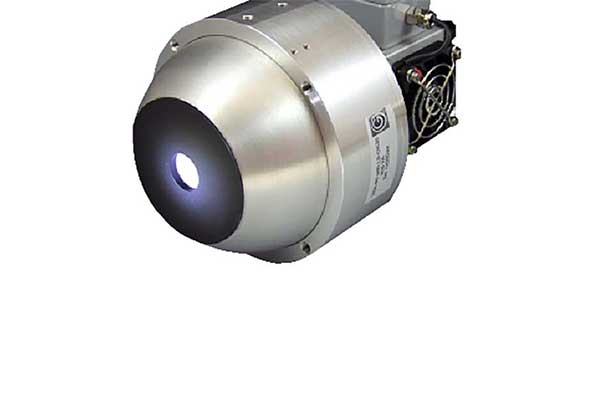
Uniform Integrating Sphere Light Sources for High Dynamic Range Test and Calibration of Imaging and non-Imaging Devices
To measure the sensitivity, linearity and non-uniformity of imaging sensors, a test setup with a reference light source is required which homogeneously irradiates the test specimen. Integrating sphere light sources with quasi monochromatic emission spectra can be used for qualifying grayscale and color sensors and camera systems. However, for the characterization of imaging sensors and systems required for more demanding photometric and spectroradiometric measurement tasks, light sources with a continuous emission spectrum are necessary. The standard illuminant for such applications is the quartz halogen lamp.
The only suitable light source with a broadband continuous emission spectrum from ultraviolet to infrared is the quartz-halogen lamp. Their spectral emission curve closely matches that of a black body over the wavelength range from 250 nm to 2500 nm. Therefore, a quartz-halogen lamp’s color temperature is approximately the operating temperature of the lamp’s filament.
Quartz halogen lamps are used as calibration standards for spectral irradiance and spectral radiant flux. For use as a calibration lamp for spectral radiance, quartz halogen lamps can be combined with an integrating sphere. Such integrating sphere light sources provide a highly uniform luminous field with near perfect Lambertian distribution [1].
For sizing the integrating sphere, the rule of thumb is that the total area of all openings in an integrating sphere light source (required for the illuminated field, sources and any monitor detectors) should not exceed 5% of the total sphere surface to ensure uniform distribution of light in the sphere. The uniformity of the light distribution within the integrating sphere also depends on suitable coating and, importantly, the design of internal baffles which are required to prevent any direct optical paths between the light source(s) and the light field at the sphere’s output port.
The spectral radiance level of the illuminated field depends on various parameters:
- Diameter of integrating sphere and size of any ports (The larger the sphere diameter and the port area, the higher the attenuation).
- Reflectance of the integrating sphere coating (the higher the reflectance, the higher the light throughput). The wavelength-specific reflectance must be taken into account.
- Size and design of internal baffle(s).
- The radiant flux within the integrating sphere:
- The radiant flux of quartz halogen lamps depends on the lamp power
- The radiant flux of quartz halogen lamps increases with their color temperature
- The full radiant flux of the quartz halogen lamp can only be coupled into the integrating sphere if the lamp is arranged inside the sphere
The linearity of imaging sensors is measured by illuminated them with different intensities. An important prerequisite for the linearity measurement is that the emission spectrum and the spatial uniformity of the reference light source must not change when the intensity is varied. For integrating sphere light sources with internal lamp arrangements, a change in intensity can only be achieved by switching the lamp on and off. This is because any change in the electrical power to the lamp causes a change in the color temperature and is therefore inadmissible. For variable intensity adjustment, the quartz halogen lamp can be placed outside the sphere. In this way the radiant flux entering the sphere can be controlled by a variable aperture. It is most important that any mechanical iris is uniformly illuminated by the quartz-halogen lamp to ensure a color temperature-neutral intensity adjustment. For this purpose, the use of reflectors with a diffuse surface has proven itself.
The possibility to use optical correction filters in front of an externally mounted quartz halogen lamp is limited because of the very high level of infrared radiation (heat) emitted by the lamp. Only filters with very low infrared absorption can be used.
To measure the sensitivity of the imaging sensors and cameras, the intensity of the luminous area can be calibrated in units of spectral radiance (W. sr-1.m-2.nm-1) and luminance (cd/m2 ). It can be provided at different intensity levels. In addition, there is the possibility of incorporating a monitor detector into the sphere’s design which is matched to the output radiance/luminance of the sphere.
Gigahertz-Optik GmbH manufactures integrating sphere light sources ranging in sphere diameter from 50 mm to 1000 mm. Standard models ISS-17-VA and ISS-30-VA, for example, are popular for calibrating the spectral radiance and uniformity of spectroradiometers, multispectral and hyperspectral sensors, etc. Additionally, the modular sphere concept from Gigahertz-Optik GmbH is geared to configuring application specific integrating sphere light sources.
References